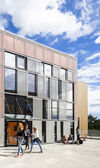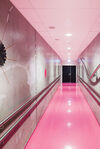Bjørnsletta skole
Undervisning- Type prosjekt Barne- og ungdomsskole med flerbrukshall
- Sted Ullern, Oslo
- Størrelse 10 000 m2
- Budsjett 450 MNOK
- Oppdragsgiver Oslo Kommune, Undervisningsbygg KF
- Status Ferdigstilt 2014
- Faser Konkurranse og detaljprosjekt
- Miljøprofil Passivhus Energimerke A Tilfredsstiller krav til FutureBuilt
- Premie Finalist i Oslo Bys Arkitekturpris 2015
- Publisert Arkitektur N nr. 6 -2014
Prosjektet er utformet med en avlang førsteetasje innpasset i terrenget og tre mindre bygningsvolumer over.
Det er uteområder for elevene på taket over første etasje mellom de tre byggene. De tre volumene inneholder elevenes hjemmeområder mens spesialutstyrte rom og fellesarealer er på plan 1. Det er tegnet en liten flerbrukshall innpasset i terreng ved atkomsten til skoletomta.
Bjørnsletta skole utvides til en 1-10 skole for 750 elever. L2 Arkitekter AS har i samarbeid med Østengen og Bergo Landskapsarkitekter AS utført en mulighetsstudie som presenterer ulike alternativer for utvidelse av skolen. Basert på ett av forslagene i mulighetsstudien er det gjennomført programmering, skisseprosjekt og planforslag for ny regulering og detaljprosjekt med byggefase.
Den nye skolen er et FutureBuilt-prosjekt med forbildefunksjon for miljøvennlige og klimaneutrale bygninger og ble ferdigstilt i 2014. Det er den første passivhusskolen som er bygget i Oslo.
The new school is laid out so that the natural landscape on the edges of the property can be retained. The school building has been kept in the style of the neighbouring buildings, with natural stone and wooden cladding as façade materials.
The ground floor of the school is set into the earth with three smaller building volumes above. The division into smaller volumes creates sight lines between the buildings and good sun and shade conditions. Parts of the roof of the first floor are used as outdoor play areas for the children, and the roof over the sports hall is a playing field.
Bjørnsletta School was built as a primary and secondary school for about 200 students in 1981. To meet today´s needs for a school of that size with space for 792 pupils, the existing school was demolished and replaced with a almost 10 000 m² new building. Schoolchildren were welcomed into the new building in 2014.
Being a model project in the Future-Built scheme, the project has aimed at meeting high environmental standards and passive house criteria. The project has focused on optimizing the technical regulation systems and using climate-friendly materials to reduce carbon emissions as well as energy consumption such as heating, cooling and ventilation.



Bjørnsletta skolen er den første passivhusskolen bygget i Oslo.

Utforming av gangforbindelsen mellom skolebygget og flerbrukshallen ble del av kunstprosjektet.

En avlang førsteetasje er innpasset i terrenget med tre mindre bygningsvolumer over.







